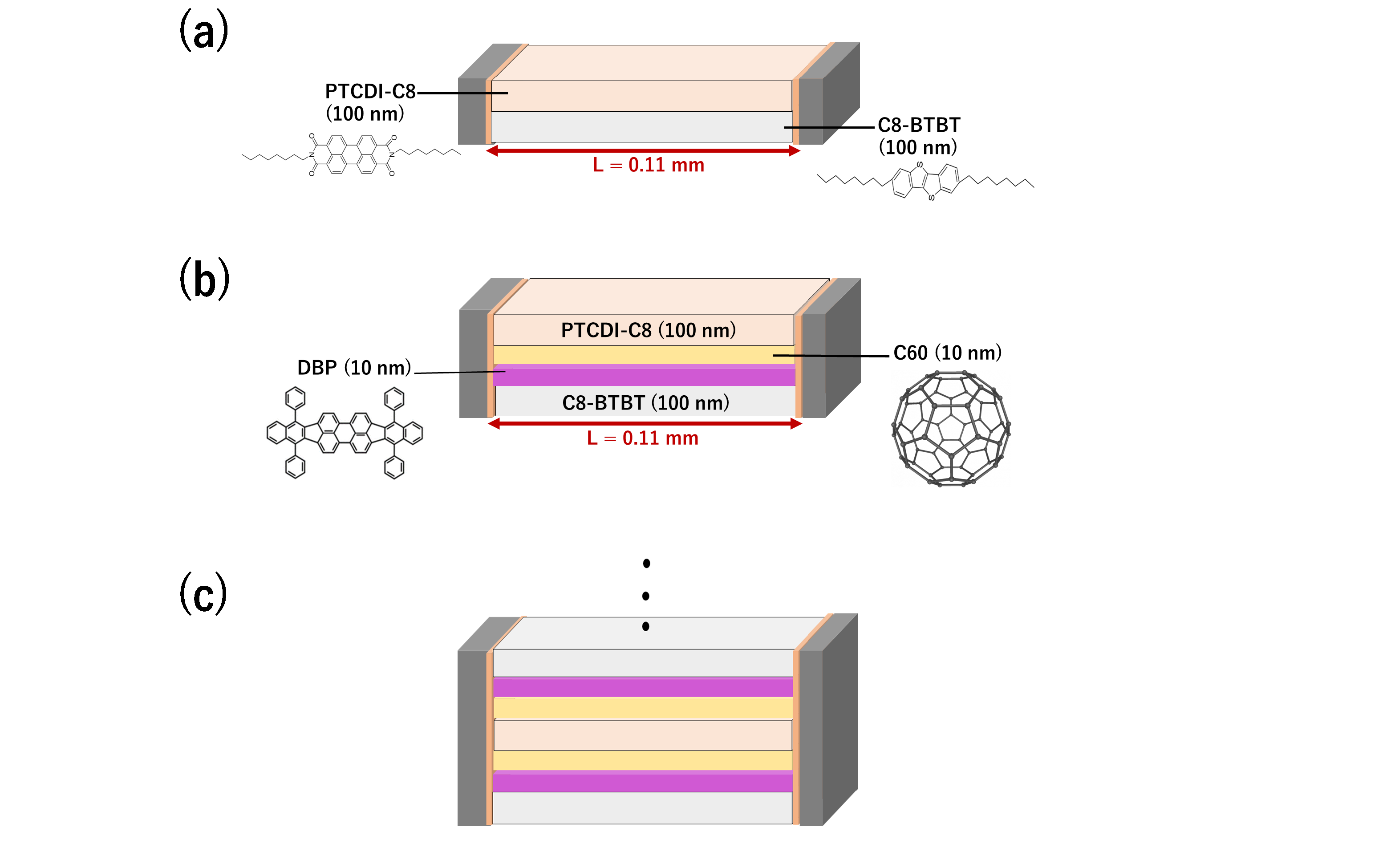2021.11.17
Lateral-tandem organic solar cells
SOKENDAI Publication Grant for Research Papers program year: 2021
Functional Molecular Science Palassery Ithikkal Jaseela
分子科学コース
Lateral-tandem organic photovoltaic cells with carrier transport and generation layers
journal: Applied Physics Express 14, 101003 publish year: 2021
DOI: https://doi.org/10.35848/1882-0786/ac28e6

Lateral cells of C8-BTBT and PTCDI-C8 without (Fig. a) and with (Fig. b) strong light absorbing films were reported here. DBP is an organic light absorbing material and C60 is well-known electron acceptor material. Thus DBP/C60 acts as carrier generating layer and C8-BTBT and PTCDI-C8 act as carrier transporting films for holes and electrons, respectively. The photocurrent has increased by incorporating the light absorbers as carrier generating layer to the conventional lateral cells. Lateral tandem cells (Fig. c) are operated by stacking the number of organic films one above the other. Thus, unlimited films can be stacked in a lateral tandem cell as represented by the dots in Fig. c
Organic Solar Cells (OSCs) are a promising candidate to solve the energy issues of the current world due to its growing population and their needs. OSCs generate electric current by generating carriers using organic semiconductors either in their crystal form or in thin films. Such organic semiconductor devices have various advantages such as low cost, flexibility, small weight, and printability. Organic semiconductors with very high mobility for carriers are already reported in previous studies. C8-BTBT and PTCDI-C8 are well known organic materials acting as electron donor and acceptor, respectively, and showing high mobilities for holes and electrons, respectively. This high mobility of carriers paved the way for the lateral organic solar cell operation in which the carriers generated are collected laterally. Thus, unlimited layers can be stacked to absorb the entire wavelength of the solar spectrum. This can overcome the thickness limitation of conventional vertical cells in which the thickness is limited to a few nanometers. Thus, the lateral cells can increase the efficiency of organic solar cells. But the photocurrent generated by these lateral cells was small compared to the typical vertical cell. It is due to the low carrier generation efficiency caused by the long insulating chains between C8-BTBT and PTCDI-C8 molecules.
To overcome this low photocurrent generation in lateral cells, organic materials having a high ability to absorb sunlight such as DBP are introduced between the C8-BTBT and PTCDI-C8. Thus, this light absorber acts as carrier generating layer and C8-BTBT and PTCDI-C8 act as carriers transporting films. A lateral cell with only a carrier-transporting layer (C8-BTBT/PTCDI-C8) (Fig. a) exhibited significantly low photocurrent density. The cells having carrier-generating and transporting layers (Fig. b) showed a larger photocurrent compared to the C8-BTBT/PTCDI-C8 lateral cells. Further, the photocurrent has drastically increased by increasing the number of carriers generating and transporting layers by stacking one over the other. Hence, the lateral tandem cell in which the number of cells is stacked one above the other was successfully operated.
The advantage of the lateral tandem cell (Fig. c) is that a single device can have several cells stacked one over the other so that the entire sunlight that falls on it can be converted to electric current. Hence a major part of the solar spectrum can be effectively converted to the photocurrent by using such solar panels. Since the organic materials are cheap, the lateral organic solar cells can be a boon to the common people. Thus, the lateral tandem cells can be the future solar cell.
Bibliographic information of awarded paper
- Title: Lateral-tandem organic photovoltaic cells with carrier transport and generation layers
- Authors: Palassery Ithikkal Jaseela, Yusuke Yabara, Uto Shoko, Seiichiro Izawa, Masahiro Hiramoto
- Journal Title: Applied Physics Express 14, 101003
- Publication Year: 2021
- DOI: https://doi.org/10.35848/1882-0786/ac28e6
Department of Functional Molecular Science Palassery Ithikkal Jaseela
